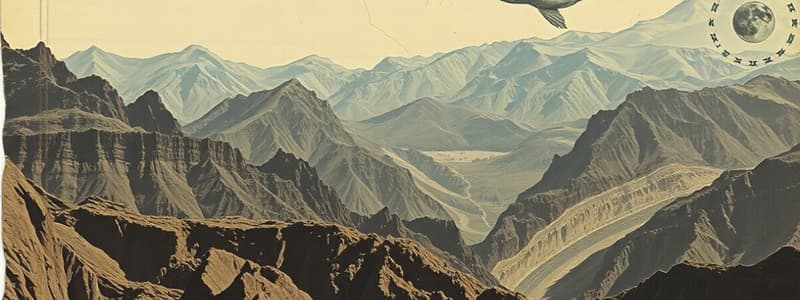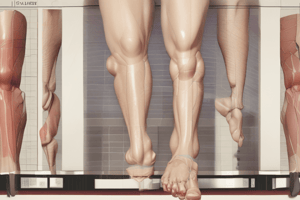Podcast
Questions and Answers
What primary observation led early mapmakers to suggest that continents might have once been joined together?
What primary observation led early mapmakers to suggest that continents might have once been joined together?
- The alignment of mountain ranges on opposite sides of the oceans.
- The patterns of ocean currents and prevailing winds around continents.
- The distribution of specific minerals across different continents.
- The close fit of continental coastlines, like a jigsaw puzzle. (correct)
Which of these geological features provides evidence supporting the theory of plate tectonics?
Which of these geological features provides evidence supporting the theory of plate tectonics?
- The consistent age of rocks found on different continental landmasses.
- The presence of shallow ocean limestone at the summits of mountains. (correct)
- The uniform distribution of sedimentary rocks across continents.
- The random distribution of fossils across various geographical locations.
What was the crucial difference in Wegener's approach to continental drift compared to his predecessors like Antonio Snider-Pellegrini?
What was the crucial difference in Wegener's approach to continental drift compared to his predecessors like Antonio Snider-Pellegrini?
- Wegener compiled and synthesized a large amount of diverse data in one comprehensive theory. (correct)
- Wegener dismissed the possibility of trans-oceanic land bridges for species dispersal.
- Wegener only considered evidence from the coastlines of Africa and South America.
- Wegener focused solely on geological evidence, ignoring biological data.
What was a common objection to the theory of continental drift, before the concept of plate tectonics was widely accepted?
What was a common objection to the theory of continental drift, before the concept of plate tectonics was widely accepted?
Why is plate tectonics considered revolutionary in the field of geology?
Why is plate tectonics considered revolutionary in the field of geology?
What key observation led Inge Lehmann to hypothesize the existence of a solid inner core?
What key observation led Inge Lehmann to hypothesize the existence of a solid inner core?
Why is Earth's liquid outer core important for sustaining life on Earth?
Why is Earth's liquid outer core important for sustaining life on Earth?
What is the primary factor that allows the inner core to remain solid despite its high temperature?
What is the primary factor that allows the inner core to remain solid despite its high temperature?
What is the main difference between passive and active tectonic margins?
What is the main difference between passive and active tectonic margins?
What occurs in the mantle wedge during subduction that leads to the formation of volcanic arcs?
What occurs in the mantle wedge during subduction that leads to the formation of volcanic arcs?
What was a significant flaw in Alfred Wegener's continental drift hypothesis?
What was a significant flaw in Alfred Wegener's continental drift hypothesis?
What evidence from ocean floor mapping supported the theory of plate tectonics?
What evidence from ocean floor mapping supported the theory of plate tectonics?
Which of the following best describes the significance of magnetic anomalies found on the ocean floor?
Which of the following best describes the significance of magnetic anomalies found on the ocean floor?
What is the study of paleomagnetism and how did it support the theory of plate tectonics?
What is the study of paleomagnetism and how did it support the theory of plate tectonics?
What are Wadati-Benioff zones and what do they indicate?
What are Wadati-Benioff zones and what do they indicate?
Which of the following statements accurately describes the Mohorovičić Discontinuity (Moho)?
Which of the following statements accurately describes the Mohorovičić Discontinuity (Moho)?
What are the primary sources of information scientists use to understand the composition and characteristics of the Earth's mantle?
What are the primary sources of information scientists use to understand the composition and characteristics of the Earth's mantle?
How does the physical behavior of the asthenosphere contribute to plate tectonic processes?
How does the physical behavior of the asthenosphere contribute to plate tectonic processes?
Which of the following comparisons accurately describes the differences between oceanic and continental lithosphere?
Which of the following comparisons accurately describes the differences between oceanic and continental lithosphere?
What is the primary basis for differentiating the Earth's layers based on chemical composition?
What is the primary basis for differentiating the Earth's layers based on chemical composition?
Flashcards
Outer Core
Outer Core
The only completely liquid layer of the Earth, 2,300 km thick.
Inner Core
Inner Core
The solid innermost layer of the Earth about 1,220 km thick, despite high temperatures.
Subduction Zone
Subduction Zone
Where one tectonic plate moves beneath another, often forming trenches.
Active Margin
Active Margin
Signup and view all the flashcards
Volcanic Arc
Volcanic Arc
Signup and view all the flashcards
Plate Tectonics
Plate Tectonics
Signup and view all the flashcards
Paradigm Shift
Paradigm Shift
Signup and view all the flashcards
Continental Drift
Continental Drift
Signup and view all the flashcards
Wegener's Evidence
Wegener's Evidence
Signup and view all the flashcards
On the Origin of Species
On the Origin of Species
Signup and view all the flashcards
Seafloor Spreading
Seafloor Spreading
Signup and view all the flashcards
Paleomagnetism
Paleomagnetism
Signup and view all the flashcards
Wadati-Benioff Zones
Wadati-Benioff Zones
Signup and view all the flashcards
Tuzo Wilson
Tuzo Wilson
Signup and view all the flashcards
Crust
Crust
Signup and view all the flashcards
Mohorovičić Discontinuity (Moho)
Mohorovičić Discontinuity (Moho)
Signup and view all the flashcards
Lithosphere
Lithosphere
Signup and view all the flashcards
Asthenosphere
Asthenosphere
Signup and view all the flashcards
Study Notes
Sevier Orogeny and Plate Tectonics
- A layer of shallow ocean limestone was brought to the top of a mountain by the convergent forces of the Sevier Orogeny near Sun River Canyon, Montana.
- "Revolution" in science refers to significant paradigm shifts that force scientists to re-evaluate their understanding, like Darwin's evolution, Mendel's genetics, Watson-Crick-Franklin DNA model, and Einstein's relativity, impacting various fields.
- Plate tectonics is a revolutionary geological theory explaining Earth's dynamic surface, attributing earthquakes, mountains, and volcanoes to the movement of massive sections of the Earth's outer layers.
Wegener's Continental Drift Hypothesis
- Wegener synthesized evidence from similar rocks, mountains, fossils, and glacial formations across oceans, proposing continents once formed a single landmass.
- Continental coastlines had a jigsaw-like fit (e.g., South America and Africa).
- Evidence included fossils of Mesosaurus and Lystrosaurus found on separate continents, implying land bridges couldn't explain the trans-oceanic distributions of land-dwelling creatures.
- Glacial deposits in warm areas and tropical plant fossils in frozen regions were evidence against land bridges.
- Wegener couldn't explain the mechanism of continental drift, a critical gap in his theory that hindered acceptance.
Evidence supporting Plate Tectonics
- Ocean floor mapping revealed the Mid-Atlantic Ridge, a basaltic mountain range.
- Harry Hess proposed seafloor spreading, a process where new oceanic crust forms at mid-ocean ridges.
- Seafloor sediment thickness provided evidence against stationary ocean floors, and supported the concept of seafloor spreading and plate movement.
- Paleomagnetism (study of magnetic fields in rocks) provided crucial evidence for plate motion with symmetrical magnetic patterns on either side of mid-ocean ridges, revealing sea floor spreading.
- Earthquake epicenters followed the shapes of oceanic plates sinking into the mantle, forming Wadati-Benioff zones. Linking earthquakes to plate motion.
Layers of the Earth: Chemical and Physical
- The Earth has three major chemical layers: crust, mantle, and core. The crust has continental and oceanic forms.
- Seismic waves provide understanding of the Earth's interior and have been used to identify the Mohorovičić Discontinuity (Moho), the boundary between the crust and the mantle.
- Physical layers include lithosphere, asthenosphere, mesosphere, outer core, and inner core.
- Lithosphere is broken into plates, with plate boundaries actively shaping Earth's surface.
- Asthenosphere is the mechanically weak layer below the lithosphere that allows for plate movement.
Types of Plate Boundaries
- Plate boundaries are categorized as convergent, divergent, and transform.
- Convergent boundaries (destructive): Plates move towards each other, leading to subduction (one plate descending beneath another) or collision (both plates have similar densities, causing uplift).
- Divergent boundaries (constructive): Plates move apart, creating new crust, like at mid-ocean ridges or rift valleys. This can be narrow, like the East African Rift, or broad, like the Basin and Range region of the western United States.
- Transform boundaries (conservative): Plates slide past each other, creating earthquakes. A notable example is the San Andreas Fault.
The Wilson Cycle
- The Wilson Cycle describes the continuous opening, closing, and reopening of ocean basins, generating supercontinents like Pangea.
- Driving mechanisms of plate movement include ridge push, slab pull, and gravitational sliding.
- Hotspots are fixed points of volcanic activity unrelated to plate boundaries, creating island chains as the plate moves over them, like the Hawaiian Islands.
Additional Concepts
- Active margins are locations where oceanic and continental plates meet with significant movement, leading to mountain building and earthquakes. Passive margins form at the juncture of plates where one plate is made up of both continental and oceanic lithosphere.
- Subduction processes often lead to the formation of volcanic arcs, which are curved chains of volcanoes.
- Collision zones result in the formation of tall, non-volcanic mountains, high earthquake activity, and little volcanism.
Studying That Suits You
Use AI to generate personalized quizzes and flashcards to suit your learning preferences.

![[01/Sevier/01]](https://images.unsplash.com/photo-1641785591533-988ea9aa353c?ixid=M3w0MjA4MDF8MHwxfHNlYXJjaHwxOHx8VGVubmVzc2VlJTIwaGlzdG9yeSUyQyUyMFBhbGVvLUluZGlhbnMlMkMlMjBBcmNoYWljJTIwcGVvcGxlcyUyQyUyMHByZWhpc3RvcmljJTIwY2l2aWxpemF0aW9uc3xlbnwxfDB8fHwxNzE1OTM2NTA1fDA&ixlib=rb-4.0.3&w=300&fit=crop&h=200&q=75&fm=webp)
